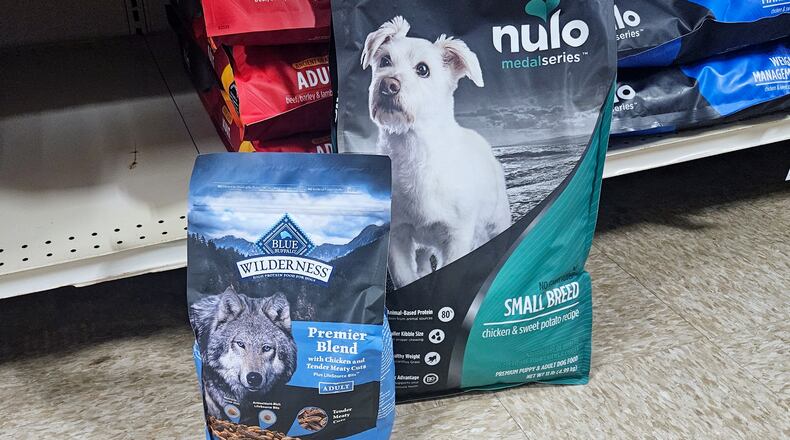Our 10-year-old beloved Lab Teddy is a healthy 65 pounds. His coat is shiny and soft, eyes clear, yearly test results good. But he’s a picky eater. One day he gobbles up both his breakfast and dinner and the next day, he won’t eat either. Some days, he’ll pick at his breakfast and not touch his dinner. But the next day, he’ll eat half of his breakfast and all his dinner.
His eating habits can be maddening.
Over the years, husband Ed, Teddy’s fearless leader, and I have tried to find the right food or combination of foods that would entice the pooch to eat more consistently.
Selecting the right food for Teddy is important, so we had to learn more about dog food labels. Previously, when thinking of adding or changing his food we first looked at the label, then asked his vet for her opinion on the food and how much should he be given at each meal.
This is what we’ve learned so far when trying to understand what’s in the bag of food we’re thinking of serving Teddy. And always ask your vet for suggestions and opinions.
On every bag of dog food, the U.S. Food and Drug Administration (FDA) requires labels to include the product name, type of animal the food is for, manufacturer’s name and address, net weight of the product, list of ingredients, feeding guidelines and the life stage for which the product is intended.
Also required on the food bag is the “guaranteed analysis,” which the FDA says must list how much protein, fat, fiber and moisture are in the food. It’s the minimum amount for protein and fat and the maximum amount for fiber and moisture. Again, ask your vet what amounts are right.
Finally, we use the four rules developed by the Association of American Feed Control Officials (AAFCO), a nonprofit that sets standards for pet food labeling practices, nutritional content, ingredient definitions, feeding trials and laboratory analysis.
Simply look at the title or description of the food to better understand what you are purchasing. Word choice matters.
According to Wag! at wagwalking.com, “While AAFCO doesn’t directly test, regulate or certify pet foods, it works closely with FDA partners and state agencies to ensure all pet food is safely manufactured and labeled properly.”
When looking at each of these four rules, we used “chicken” as the example. Teddy usually prefers chicken over other meats, so we gravitate toward it when looking at food and treats.
AAFCO’s first rule is straightforward: 95% of the food in the bag must be the named ingredient. Teddy’s food, Iams Proactive Health, says on the bag, “#1 ingredient is chicken,” so according to the AAFCO, the product must be 95% chicken. In addition, this chicken must be at least 70% of the total product when counting the added moisture. Ingredients such as vitamins and minerals comprise the remaining 5%.
The second rule looks at the words dogfood companies use to describe their product. The 25% rule looks at qualifiers like “supper,” “feast” or “recipe” that are used when the named ingredient is at least 25% but less than 95% of the total product. If you count the moisture, then it’s at a low 10% of the product. If more than one ingredient is included in a “supper,” all the named ingredients must total 25% of the product and be listed in the same order on the ingredient list. In the photo, the Nulo bag of dog food uses the word “recipe” to describe its food.
The third rule involves any dog food that uses the word “with.” When that word appears, the ingredient being referred to must be at least 3% of the product. In the same photo the word “with” is used to describe the dog food in the Blue Wilderness Premier Blend – “with” chicken and tender meaty cuts plus lifesource bits.
The fourth rule is The Flavor Rule. According to the FDA, if the label reads “chicken flavor dog food,” then the precise percentage is not required, but there should be enough chicken for the product to taste like chicken. The word “flavor” must appear on the label in the same size, style, and color as the word “chicken.”
We looked in a pet store and didn’t find a dog food that used the word “flavor.” But in a retail box store, we found several canned dog foods that used the word. Again, ask your vet before using any of these products.
Finally, Teddy is eating one cup of Iams Proactive Health with a handful of shredded cheddar cheese on top at each meal. And he’s eating like he always has. He’s finicky, but as long as he stays healthy, his parents are going to stop worrying about it.
Karin Spicer is a member of The Dog Writers Association of America and The Cat Writer’s Association. She can be reached at spicerkarin@gmail.com.
The Association of American Feed Control Officials (AAFCO) provides nutritional adequacy statements for the following diets:
1. Growth and reproduction (puppies, kittens, pregnant and nursing animals)
2. Adult maintenance
3. All life stages
About the Author

